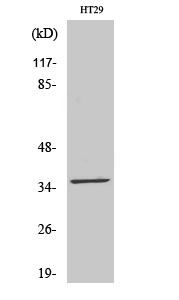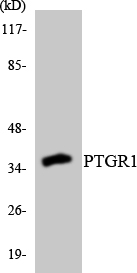LTB4DH Polyclonal Antibody
- Catalog No.:YT2597
- Applications:WB;ELISA
- Reactivity:Human;Rat;Mouse;
- Target:
- LTB4DH
- Gene Name:
- PTGR1
- Protein Name:
- Prostaglandin reductase 1
- Human Gene Id:
- 22949
- Human Swiss Prot No:
- Q14914
- Mouse Swiss Prot No:
- Q91YR9
- Immunogen:
- The antiserum was produced against synthesized peptide derived from human PTGR1. AA range:75-124
- Specificity:
- LTB4DH Polyclonal Antibody detects endogenous levels of LTB4DH protein.
- Formulation:
- Liquid in PBS containing 50% glycerol, 0.5% BSA and 0.02% sodium azide.
- Source:
- Polyclonal, Rabbit,IgG
- Dilution:
- WB 1:500 - 1:2000. ELISA: 1:5000. Not yet tested in other applications.
- Purification:
- The antibody was affinity-purified from rabbit antiserum by affinity-chromatography using epitope-specific immunogen.
- Concentration:
- 1 mg/ml
- Storage Stability:
- -15°C to -25°C/1 year(Do not lower than -25°C)
- Other Name:
- PTGR1;LTB4DH;Prostaglandin reductase 1;PRG-1;15-oxoprostaglandin 13-reductase;NADP-dependent leukotriene B4 12-hydroxydehydrogenase
- Observed Band(KD):
- 36kD
- Background:
- This gene encodes an enzyme that is involved in the inactivation of the chemotactic factor, leukotriene B4. The encoded protein specifically catalyzes the NADP+ dependent conversion of leukotriene B4 to 12-oxo-leukotriene B4. A pseudogene of this gene is found on chromosome 1. Alternative splicing results in multiple transcript variants. [provided by RefSeq, Mar 2009],
- Function:
- catalytic activity:11-alpha-hydroxy-9,15-dioxoprost-5-enoate + NAD(P)(+) = (5Z)-(13E)-11-alpha-hydroxy-9,15-dioxoprosta-5,13-dienoate + NAD(P)H.,catalytic activity:n-alkanal + NAD(P)(+) = alk-2-enal + NAD(P)H.,function:Functions as 15-oxo-prostaglandin 13-reductase and acts on 15-oxo-PGE1, 15-oxo-PGE2 and 15-oxo-PGE2-alpha. Has no activity towards PGE1, PGE2 and PGE2-alpha (By similarity). Catalyzes the conversion of leukotriene B4 into its biologically less active metabolite, 12-oxo-leukotriene B4. This is an initial and key step of metabolic inactivation of leukotriene B4.,similarity:Belongs to the NADP-dependent oxidoreductase L4BD family.,subunit:Monomer or homodimer.,tissue specificity:High expression in the kidney, liver, and intestine but not in leukocytes.,
- Subcellular Location:
- Cytoplasm .
- Expression:
- High expression in the kidney, liver, and intestine but not in leukocytes.
- June 19-2018
- WESTERN IMMUNOBLOTTING PROTOCOL
- June 19-2018
- IMMUNOHISTOCHEMISTRY-PARAFFIN PROTOCOL
- June 19-2018
- IMMUNOFLUORESCENCE PROTOCOL
- September 08-2020
- FLOW-CYTOMEYRT-PROTOCOL
- May 20-2022
- Cell-Based ELISA│解您多样本WB检测之困扰
- July 13-2018
- CELL-BASED-ELISA-PROTOCOL-FOR-ACETYL-PROTEIN
- July 13-2018
- CELL-BASED-ELISA-PROTOCOL-FOR-PHOSPHO-PROTEIN
- July 13-2018
- Antibody-FAQs
- Products Images

- Western Blot analysis of various cells using LTB4DH Polyclonal Antibody

- Western blot analysis of lysates from HT-29 cells, using PTGR1 Antibody. The lane on the right is blocked with the synthesized peptide.

- Western blot analysis of the lysates from 293 cells using PTGR1 antibody.



